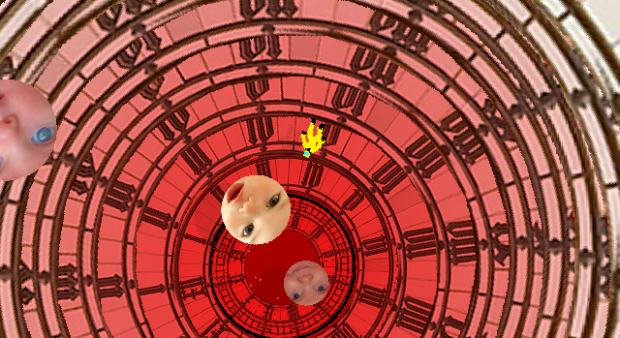Jonatan Soderstrom, aka “cactus,” stole the show at last year’s Independent Games Summit with his surreal, multimedia presentation entitled “The Four-Hour Game Design.“
(Also: if you don’t know who cactus is, I’d suggest you spend the next week playing through every game he’s ever made. They’re alternately wacky, fun, surreal, irritating, totally independent experiences.)
This year, cactus delivered a talk about, in his words, “abusive design, and why you’d want to be mean to your players.”
Hit the jump for a summary of his talk.
Cactus’s talk opened with a seizure warning. Because that’s kind of how he rolls. Every bit of text he presented on screen hovered in front of a harsh, constantly rotating combination of black and white stripes that hurt my eyes after a few seconds of intense staring. Thematic coupling at its best.
So, why would you want to be mean to your players? According to Soderstrom, most games are really easy, and worrying about what your player may be feeling and if they feel comfortable can compromise your vision as a designer. It’s more fun to just be free, and do what you want to do without caring how the player will feel. You can also find new players if you do something unusual — a lot of people don’t like “normal” games.
Soderstrom went on to spend a great deal of time likening games to movies. Long story short: fantastic, surreal works can be found quite frequently in film (El Topo, the works of David Lynch and Stanley Kubrick), but almost never in videogames. Soderstrom argued that David Lynch’s videogame equivalent might be Suda 51 given how trippy Killer 7 was, but No More Heroes was more MTV than Lynch.
Shadow of the Colossus borrowed a lot of narrative stuff from El Topo, but the visuals and style, Soderstrom argued, shared more in common with Studio Ghibli films. And these works are fine, but they aren’t pure, unique, unfiltered self-expression like David Lynch films are.
Soderstrom quoted John Holmstrom, referring to progressive rock: prog rock was for people who weren’t good at music, but had a need to express something personal. And that’s the idea behind abusing, or ignoring, your player.
But if you can’t program, what do you do? Soderstrom suggests using Klik-n’-play, or Game maker, which is what he uses. Nonprogrammers might not follow established rules of game design, and might create the kinds of games they’d personally like to see made. That’s what auteurs do, and can end up being really interesting.
Soderstrom used Matt Alridge’s La La Land series as a great example of player-abusive personal expression: the La La Land games have bad graphics and extremely limited interaction, eliciting a sort of “WTF” vibe from players, but to Soderstrom, the games prove that you can make games with limited interaction, but still have that interaction enhance the experience and make the game interesting.
“[Mark Essen, aka messhof] is kind of my idol,” Soderstrom continued. Messhof’s games are all extremely abusive, but extremely personal: they’re really hard, really simplistic, and really restrained. Cactus showed a video playthrough of Punishment before briefly touching on Flywrench (“I think it should have been nominated for an IGF award at one point”), and how the mechanics force you to play the game like a speedrunner. JPH Wachesky’s games were also singled out.
After highlighting his favorite abusive designers, Soderstrom moved into the question of how to make an abusive game. Starting with graphics, you can create blinking, rotating, or psychadelic patterns that make things really annoying for the player.
In terms of actual gameplay mechanics, you can create weird, inconsistent logic for your games that doesn’t seem to make immediate sense. As an example, Cactus showed a level from his game Mondo Medicals, where you’re in a maze and a bunch of arrows painted on the floor seem to direct you to the exit. By following the arrows, however, you end up going around in an infinite circle; to proceed, you need to ignore the arrows and go backwards, which results in the spontaneous appearance of a new door that couldn’t have physically existed there before. “You don’t really understand how it works,” he said, “but it’s a game and you don’t care.”
Weird logic allows you to create fresh puzzles really easily — the Mondo Medical level in question only took him an hour to make — and you can have a really varied game if you don’t force yourself to follow established rules.
To further illustrate this, Soderstrom played through a little bit of Psychosomnium. I don’t wanna bother saying which part, because you should really play Psychosomnium for yourself (doesn’t take long).
The problem with weird logic, Soderstrom admits, is that it might feel too random and arbitrary, and it’s really hard to adjust the difficulty of your puzzles if you’re just being random.
Alternately, you can use “insane difficulty” to keep your players surprised. I Wanna Be the Guy is singled out as an ideal example. A game like IWBTG is not completely unfair, but it forces the player to do things they’re unused to, as well as treating difficulty like a puzzle in and of itself. This ends up creating a sort of slapstick atmosphere, where constant death is a punchline. To prove his point, Cactus showed this video.
Soderstrom began to play another demo of a game I didn’t recognize before running out of time and wrapping up his talk with an unceremonious nod.




